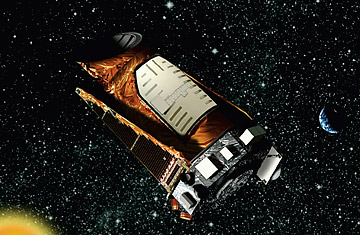
An artist rendition of the Kepler space telescope
Searching for planets around distant stars isn't easy. A few of the hundreds of extrasolar planets discovered so far have been found the old-fashioned way — by taking the planets' pictures through powerful telescopes. But the vast majority have called for more ingenious approaches. Planet hunters have found extrasolar planets by watching for the subtle wobble in a star's position as a planet's gravity tugs it back and forth. They've noted the almost imperceptible dimming of a star's light as a planet passes between it and Earth. They've seen a distant star twinkle, first brightly and then faintly, as a nearer star, and then its planet drift by.
But a new way to find planets may be the most ingenious yet. Writing in the Astrophysical Journal, Harvard graduate student Sarah Ballard and several colleagues have announced the discovery of a world orbiting a star about 650 light-years from Earth, in the constellation Lyra, whose presence was revealed by its gravitational pull on another planet — a planet that itself can be detected only indirectly.
A double bank shot like that seems unreliable, but the method is actually quite persuasive — and even precise — when Ballard explains it. It all starts with Kepler, the space telescope that has been staring at 150,000 or so stars in the northern sky since 2009. It's waiting for at least some of those stars to display the telltale dimming that would be the sign of a transiting planet.
To make sure that the flicker is indeed a planet and not something else (a star spot, a glitch in the electronics or a long list of other possibilities), astronomers conduct a series of tests so they can rule out so-called false positives, like police ruling out suspects in a murder investigation. One such test involves calling on one of Kepler's sister spacecraft, the infrared-sensitive Spitzer Space Telescope, to train its eye on a "Kepler object of interest," or KOI (even the language is parallel with cop talk's person of interest). If the same kind of dimming happens in infrared light as Kepler sees in visible light, that's a strong sign that a planet is indeed responsible. (Star spots and other sources of false positives would have a different infrared signature.)
As part of this Spitzer follow-up program, Ballard and her colleagues helped confirm that the first planet around the star known as Kepler 19 was indeed a planet, with a diameter about twice as big as Earth, orbiting once every 223 hours — or nine days and change. That puts it only 8.4 million miles (13.5 million km) from the star, compared with Earth's 93 million miles (150 million km), so the world, called Kepler 19b, is simmering at about 900°F (482°C).
But when Ballard tried to nail down 19b's precise orbit, it didn't make sense. "It was smeared out," she says, meaning that it would start its transit five minutes earlier than it should, and then, over a period of 150 days, it would morph gradually to five minutes late and then back again — just like clockwork, except the clock was gradually speeding up then slowing down. Something was clearly pulling on the planet. Based on the amount of that pulling, other members of the team figured out it must be a second planet.
This isn't the first time variations in transit timing have been used to make a discovery. A year ago, Harvard astronomer Matt Holman used the technique — which he helped invent — not to find a planet, but to deduce the masses of two planets the Kepler probe had already found. One drawback of Kepler is that while it can measure a planet's size by how much starlight it blocks, that doesn't provide clues to the mass. However, you need both size and mass to get a planet's density and thus to figure out whether it's made of rock, like Earth, or gas and ice, like Neptune, or mostly gas, like Jupiter. Transit-timing variations had never before been used to find a planet you can't see otherwise. "We think this is the first robust detection," Ballard says, alluding to earlier claims that didn't pan out.
What she and her colleagues can't say about this new planet is ... pretty much anything other than the fact it exists. The effect it has on Kepler 19b could be caused by a big planet orbiting farther away or by a small planet between 19b and its star. "The mass and the orbital period," Ballard concedes, "are unknown."
The exciting part, she says, is that the new technique, which wasn't even invented when Kepler was originally approved by NASA, should continue to make the probe more useful than anyone anticipated. "We're entering uncharted waters," she says. "I predict that this will open the floodgates. Dozens of planets will be discovered this way in the future."
